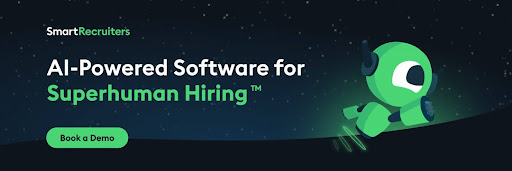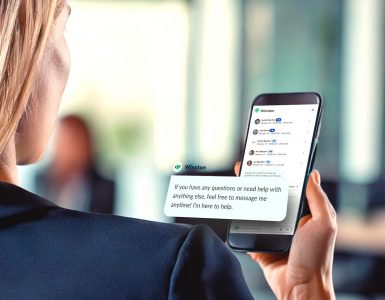The broad strokes of AI’s full value are beginning to take shape. The rate and scope of adoption are astonishing, with the number of organizations using generative AI (Gen AI) nearly doubling year-over-year. Using AI in recruiting is a key focus for organizations looking to hire faster and smarter.
Already, 70% of companies are experimenting with AI in HR, and within HR, the top use case is talent acquisition. AI in recruiting has huge potential to improve hiring pipelines and make teams more efficient. It can also reduce hiring bias, improve the candidate experience, and improve the overall quality of hires.
Best tasks for AI in recruiting
Recruiting AI supercharges human recruiters, giving them more hours in the day, deeper insights into the hiring funnel, and more reach into candidate pools. This article highlights seven key recruiting tasks that AI is already taking over:
- Sourcing candidates
- Matching candidates to job descriptions
- Communicating with candidates
- Writing job descriptions, emails, interview questions, and more
- Assessing candidates objectively
- Intelligently automating the recruitment pipeline
- Delivering predictive analytics
1. Sourcing candidates
Candidate sourcing traditionally requires hours of meticulously searching for, identifying, and engaging candidates. While this work is crucial, the manual process is inefficient, produces uneven results, and can be the most tedious part of a recruiter’s day.
AI-driven sourcing tools like LinkedIn Recruiter and hireEz dramatically reduce the effort needed for active sourcing by combing through LinkedIn, social media, talent databases, and other sources to find qualified individuals for a role. Gen AI can even automate initial outreach to candidates.
Candidate sourcing is an excellent example of how AI for recruiting supports human recruiters, rather than replacing them. When a prospect responds to the initial automated message, a human can take over the nurture process to build individual relationships and a talent pipeline to improve future recruiting.
2. Matching candidates to job descriptions
Job seekers are straining hiring pipelines by automating the application process with AI. Now, applying for a position can be done with minimal effort, which encourages quantity over quality. Some recruiters and hiring managers are flooded with applications, forcing them to sift through poorly matched resumes.
Recruiting AI can automate initial screening on the basis of specific skills, experiences, and qualifications. Compared to earlier tools, current LLM-based AI technologies upgrade the accuracy of match scores, recognizing skills with higher fidelity and improving as the AI learns over time. AI-driven candidate matching can also help overcome human bias by excluding factors such as race, ethnicity, university names, and gender from the training data that could prejudice the model.
3. Communicating with candidates
When recruiters are challenged to find time to engage with candidates, a lack of connection to can lead to dehumanizing effects on the hiring process. Much of the time they do spend on communication can be consumed by transactional conversations about process and logistics.
NLP-based chatbots have helped reduce that load in recent years, with rules-based logic providing a sort of interactive FAQ service. The key limitation of NLP chatbots is their ability to deliver only pre-written responses on the basis of key phrases in candidate questions.
LLM-based chatbots are far more sophisticated than those rules-limited predecessors. They are built to understand novel human questions and generate unique responses. By emulating true human conversation, LLM chatbots dynamically and adapt, reducing friction throughout the hiring process. Next-level chatbots are also built to engage with candidates throughout the hiring process, adding an engagement layer on activities that occur in the ATS.
4. Writing job descriptions, emails, interview questions, and more
The hiring process inevitably requires creating a substantial amount of written support materials. That writing adds substantial overhead for recruiters—from job descriptions and candidate emails to interview questions, scorecard criteria, and offer letters.
Generative AI copilots reduce that burden. Increasingly sophisticated copilots are being incorporated into modern ATSs to handle common writing tasks. While stand-alone Gen AI tools such as ChatGPT have similar functionality, a copilot integrated into the ATS offers critical advantages in terms of efficiency and regulatory compliance.
A built-in Gen AI copilot inherits the ATS’s data access and privacy controls, such as for compliance with Equal Employment Opportunity (EEO) guidelines and SOC 2 standards. Stand-alone Gen AI tools require workarounds to compensate for their lack of integration, which can create inefficiencies and expose sensitive data.
5. Assessing candidates objectively
Objectively assessing and comparing candidates on hard-to-quantify soft skills such as teamwork, adaptability, and leadership potential is challenging. Those characteristics may be critical to a candidate’s success in the position, particularly for public-facing roles where mass hiring is common. Equally, hard skills like coding and mathematical ability can be crucial to job success in technical roles.
AI assessments for recruiting can examine candidates on both hard skills and abstract qualities such as empathy or attention to detail, giving hiring teams objective metrics for comparison. Analysis can include both an applicant’s actual responses and how that applicant interacts with a questionnaire, for example, such as whether they hesitate, rewrite their answers, skip around, etc.
These holistic assessments can be far more bias-free than humans by eliminating identifying information from data sets and running checks against results to verify objectivity. Integrating AI-powered assessments into the ATS maximizes efficiency by automatically triggering the assessment and surfacing the results directly within the core hiring platform.
6. Intelligently automating the recruitment pipeline
Recruiters spend a significant part of their days on tedious but necessary tasks that don’t make the most of their skills. For example, scheduling interviews is a common pain point identified by hiring teams, where time-consuming frustration often reigns.
AI agents will be an essential component of next-generation recruiting pipelines. These autonomous assistants are capable of planning and completing complex tasks. They can complete tasks like creating job descriptions, screening candidates, and scheduling interviews without being given explicit, step-by-step instructions every time.
The availability of AI agents as collaborators will be a principal contributor to recruiters’ efficiency and effectiveness in the coming years, streamlining the hiring process and significantly reducing manual tasks.
7. Delivering predictive analytics
Pinpointing inefficiencies in recruitment pipelines is complicated by everything from data silos to human factors. In some systems, identifying the “right” inefficiencies to look for (and the corresponding metrics) can be difficult, making it easy to misdirect resources.
AI recruiting tools can apply predictive analytics to reveal optimization opportunities in the hiring pipeline. For example, the AI can automatically surface bottlenecks where applicants spend inordinate time or are most likely to drop out of the application process. Insights based on that analysis can suggest steps for improvement that drive up recruiting efficiency and overall hiring effectiveness.
Superhuman hiring in the age of AI
SmartRecruiters, a Leader in talent acquisition suites according to Gartner, elevates recruitment with AI-driven functionality from Winston, including a candidate LLM chatbot, AI-driven matching, and a recruiter-facing AI hiring companion. The platform integrates with a large and growing partner ecosystem of vetted AI-based tools that make the environment highly extensible, with integrated point solutions for sourcing, assessment, and interviewing, to name just a few.
By automating away administrative tasks, SmartRecruiters scales up recruiting capacity at current staff levels and frees recruiters to focus on the human dimensions of hiring.
To discover how SmartRecruiters, assisted by Winston, can add a touch of joy to the hiring process, get in touch for a demo today.






